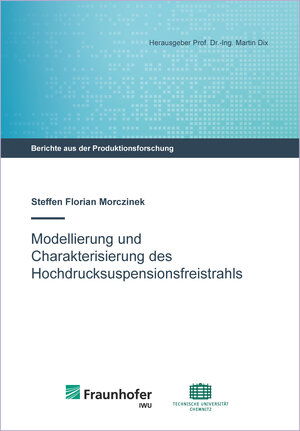
×
![Buchcover ISBN 9783957351968]()
Modellierung und Charakterisierung des Hochdrucksuspensionsfreistrahls
Berichte aus der Produktionsforschung
von Steffen Florian Morczinek, herausgegeben von Martin DixDer Hochdrucksuspensionsstrahl ist ein Wasserabrasivstrahlverfahren und dient als Werkzeug zur Bearbeitung eines breiten Spektrums an Hochleistungswerkstoffen. Für das Verständnis des Wirkens dieses Werkzeugs und als Grundlage für Erosionsmodelle ist es notwendig, das Verhalten, der für den Werkstoffabtrag verantwortlichen Partikel, in Abhängigkeit der relevanten Prozessparameter zu analysieren und mathematisch zu beschreiben. Im Rahmen der vorliegenden Arbeit wird anhand von Vorbetrachtungen zur Suspensionsstrahltechnologie ein Modellansatz eruiert, anhand dessen der Suspensionsfreistrahl bezüglich der Partikel zu dem Zeitpunkt direkt vor dem Auftreffen auf der Werkstückoberfläche beschrieben werden kann. Mittels einer Versuchsreihe zur Partikelgrößenänderung verursacht durch den Beschleunigungsprozess in der Schneiddüse kann die Masse der wirkenden Einzelpartikel berechnet werden. In einer zweiten Versuchsreihe wird die Geschwindigkeit der Partikel im Strahl gemessen. Aus den Ergebnissen der beiden Versuche kann die kinetische Energie der Einzelpartikel berechnet werden. In einer weiteren Versuchsreihe wird die Auffächerung des Freistrahls untersucht, um die reale Kontaktfläche zwischen Suspensionsstrahl und Werkstückoberfläche zu ermitteln. Die vierte Versuchsreihe gilt der Untersuchung bezüglich der Partikelverteilung im Strahl, um aus dieser die Intensitätsverteilung der Partikel im Suspensionsstrahl abzuleiten. Mittels dieser Versuchsreihen wird ein semi-analytisches Modell aufgestellt, durch das die Partikeleigenschaften nach Düsenaustritt charakterisiert werden können. Aus den über den Suspensionsstrahl gewonnenen Erkenntnissen werden abschließend Prozessoptimierungen beschrieben.
The high-pressure suspension jet is an abrasive water jet process and serves as a tool for machining a wide range of high-performance materials. In order to understand the effect of this tool and as a basis for erosion models, it is necessary to analyse and mathematically describe the behaviour of the particles responsible for material removal as a function of the relevant process parameters. Within the scope of the present work, a modelling approach is determined on the basis of preliminary analyses of suspension jet technology, which can be used to describe the suspension free jet with regard to the particles at the time directly before they hit the workpiece surface. Using a series of tests on the particle size change caused by the acceleration process in the cutting nozzle, the mass of the acting individual particles can be calculated. In a second series of tests, the velocity of the particles in the jet is measured. The kinetic energy of the individual particles can be calculated from the results of the two tests. In a further series of tests, the fanning out of the free jet is investigated in order to determine the real contact area between the suspension jet and the workpiece surface. The fourth series of tests is used to analyse the particle distribution in the jet in order to derive the intensity distribution of the particles in the suspension jet. These test series are used to set up a semi-analytical model that can be used to characterise the particle properties after nozzle outlet. Finally, process optimisations are described based on the knowledge gained from the suspension jet.
The high-pressure suspension jet is an abrasive water jet process and serves as a tool for machining a wide range of high-performance materials. In order to understand the effect of this tool and as a basis for erosion models, it is necessary to analyse and mathematically describe the behaviour of the particles responsible for material removal as a function of the relevant process parameters. Within the scope of the present work, a modelling approach is determined on the basis of preliminary analyses of suspension jet technology, which can be used to describe the suspension free jet with regard to the particles at the time directly before they hit the workpiece surface. Using a series of tests on the particle size change caused by the acceleration process in the cutting nozzle, the mass of the acting individual particles can be calculated. In a second series of tests, the velocity of the particles in the jet is measured. The kinetic energy of the individual particles can be calculated from the results of the two tests. In a further series of tests, the fanning out of the free jet is investigated in order to determine the real contact area between the suspension jet and the workpiece surface. The fourth series of tests is used to analyse the particle distribution in the jet in order to derive the intensity distribution of the particles in the suspension jet. These test series are used to set up a semi-analytical model that can be used to characterise the particle properties after nozzle outlet. Finally, process optimisations are described based on the knowledge gained from the suspension jet.


